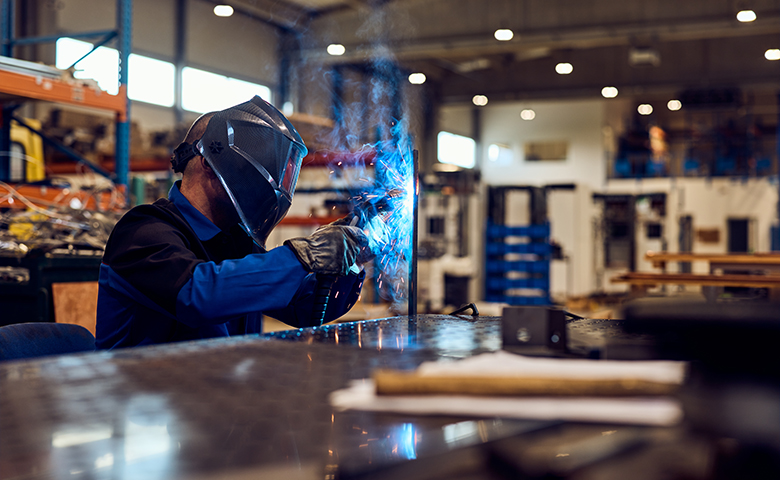Arc flash incidents are a surprisingly challenging safety issue to contend with. On one hand, the basics of arc flash safety are clear, from wearing PPE and using insulated tools to de-energizing equipment whenever possible. On the other hand, it’s hard to even say how many arc flash incidents occur each year. The National Fire Protection Association conducted a study that suggests somewhere between 10 and 15 incidents occur each day, although they note that other sources suggest up to 30,000 arc flashes occur each year—that’s a rate of over 80 per day.
If it’s difficult to count how many arc flashes occur each year, it can be even harder for workers to stay vigilant to the possibility of an arc flash happening to them, especially if they haven’t witnessed an electrical arc in a while.
Given that an arc flash can cause a surge of temperature that reaches 35,000°F (not to mention damaged equipment, flying shrapnel and more), it’s imperative that safety managers and crew leaders take every step possible to limit the risks of these types of electrical incidents. And if the standard prevention efforts have been implemented in a workplace—engineering controls are in place, PPE is being used consistently and arc flash prevention training has been conducted—then it’s time to take more advanced steps to keep workers safe.
Preventive maintenance and preventive recognition
Just like any other piece of equipment, electrical tools are subject to daily wear and tear. And over the course of weeks, months and years, failure points can occur in even the hardiest tool. Insulation can become less effective, connection points can become damaged, issues can occur with busbars. All of this can lead to a heightened risk of an arc flash.
Equipment inspection and maintenance should become part of a worker’s routine in the same way that wearing PPE is. And employees should feel comfortable speaking up if they spot a safety issue with their tools. After all, an inspection is only useful if the employer is willing to remedy any concerns that are uncovered.
Keep in mind that the work environment can change over time in much the same way that equipment does. Warning labels can peel off, engineering controls may be damaged or become faulty, and a whole host of other environmental issues can arise that influence the likelihood of an arc flash. Identifying these changes as they happen and doing something about them—before they lead to an incident—is a proactive way to prevent serious electricity-related injuries.
Stronger supervisors to stop arc flashes
It’s great news if a workplace hasn’t experienced an arc flash in a long while. But it also means that those workplaces have to contend with another safety issue: complacency, which is an underrecognized contributing factor in many incidents, including electrical arcs.
One of the best ways to shake off complacency is with a well-timed intervention from a safety professional or, better yet, the workers’ direct supervisor. This intervention could be a toolbox talk, a one-on-one discussion, or a casual group chat at lunch or during a break.
The key factor here is that the supervisor or crew leader needs to have strong communication skills. Not all frontline leaders are built the same, and those with strong supervisory communication skills are more likely to make an impact when they highlight the risks of arc flashes, electrical incident prevention and other safety issues. For companies with supervisors who lack these critical skills, additional coaching and training can build communication capacity, which can lead to fewer electrical incidents.
Human factors training for better electrical safety
Because even low voltages can lead to arc flashes, OSHA recently released guidance stating that almost all energized work over 50V requires a worker to wear PPE that includes clothing rated for arc flashes.
What the guidance did not state is the fact that all the issues that negatively influence PPE compliance in other situations are also in play when it comes to electrical concerns. This means that when workers are rushing, fatigued or affected by other mental and physical states—including complacency—they are more likely to forgo the PPE that will protect them from arc flashes and other electrical safety issues.
They’re more likely to skip other things too, like inspecting their electrical tools, locking out equipment when necessary and adhering to the established arc flash boundary. Given all this, it’s clear that human factors are a major influence on the safety of your workers, particularly in workplaces where the danger of arc flashes is already present.
The good news is that proper human factors training can reduce the risk of an arc flash occurring by helping workers recognize when their states could contribute to an incident. The training will also give them the skills to take the proper steps to address human factors in real time. The best human factors programs can also upskill supervisors and give an organization’s senior leadership team a roadmap to manage human factors in an effective and sustainable way.
And while human factors training is an effective way to proactively reduce the risk of arc flashes causing serious injuries in your workplace, it can help with a number of other safety issues as well. So if you’ve adhered to all the basic arc flash safety best practices, then it may be time to shift your workplace’s focus to preventive inspections and maintenance, improving supervisor skills and managing human factors

